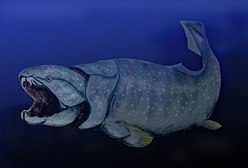Arthrodira
| Arthrodira Temporal range: Devonian |
|
|---|---|
 |
|
| Dunkleosteus terrelli | |
| Scientific classification | |
| Kingdom: | Animalia |
| Phylum: | Chordata |
| Class: | †Placodermi |
| Order: |
†Arthrodira Woodward, 1891 |
| Suborders and infraorders | |
|
and see text |
|
and see text
Arthrodira is an order of extinct armoured, jawed fishes of the class Placodermi that flourished in the Devonian period before their sudden extinction, surviving for about 50 million years and penetrating most marine ecological niches.
Greek for "jointed neck", the arthrodires had movable joint between armor surrounding the head and body. The mouth is interesting because as the lower jaw moved down, the head shield moved, allowing for a large opening. Lacking distinct teeth, like all placoderms, they used the sharpened edges of a bony plate as a biting surface. The eye sockets are protected by a bony ring, a feature shared by birds and some ichthyosaurs. Early arthrodires, such as the genus Arctolepis, were well-armoured fishes with flattened bodies. The largest member of this group, Dunkleosteus, was a true superpredator of the latest Devonian period, reaching 1 to as much as 6 m in length. In contrast, the long-nosed Rolfosteus measured just 15 cm.
A common misconception is the arthrodires (along with all other placoderms) were sluggish bottom-dwellers that were outcompeted by more advanced fish. Leading to this misconception is that the arthrodire body plan remained relatively conserved (that is, the majority of arthrodires were bullet- or torpedo-shaped) during the Devonian period, save for increasing in size. However, during their reign, the arthrodires were one of the most diverse and numerically successful, if not the most successful, vertebrate orders of the Devonian, occupying a vast spectrum of roles from apex predator to detritus-nibbling bottom dweller. Despite their success, the arthrodires were one of many groups eliminated by the environmental catastrophes of the Late Devonian extinction, allowing other fish such as sharks to diversify into the vacated ecological niches during the Carboniferous period.
...
Wikipedia
